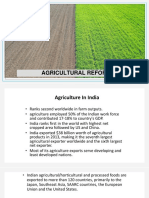Agricultural Reforms: The Game Changing Agenda of NDA Government
Agricultural Reforms: The Game Changing Agenda of NDA Government
Uploaded by
Sahil KambojCopyright:
Available Formats
Agricultural Reforms: The Game Changing Agenda of NDA Government
Agricultural Reforms: The Game Changing Agenda of NDA Government
Uploaded by
Sahil KambojOriginal Title
Copyright
Available Formats
Share this document
Did you find this document useful?
Is this content inappropriate?
Copyright:
Available Formats
Agricultural Reforms: The Game Changing Agenda of NDA Government
Agricultural Reforms: The Game Changing Agenda of NDA Government
Uploaded by
Sahil KambojCopyright:
Available Formats
Agricultural Reforms: The Game Changing
Agenda of NDA Government
Prof. Ramesh Chand*
Since 1970 Agriculture sector has experienced cyclical growth path around long-
run annual average of 2.8 per cent. This is in sharp contrast to performance of non
agriculture sector which shows acceleration in growth over time particularly after
1991 when the country embraced economic reforms. As a consequence the
disparities in growth path of agriculture and non agriculture sectors increased
sharply after early 1990s. These disparities got translated to disparities in per
worker income in agriculture and non agriculture and income of cultivators and
non farm workers. A worker in agriculture sector earned less than one fifth of
income of non agriculture worker and a cultivator (farmer) earned less than one
third of the income of a non farm worker during 2011-12. Slow growth in
agricultural income and rising disparities are the major source of persistent
agrarian distress in the country which has become a serious challenge for the
country.
NDA government at the Centre has adopted two pronged strategy to address the
twin challenges of raising agricultural growth and enhancing welfare of farmers.
The strategy is a significant departure from the past where the country chased only
production and related targets but did not explicitly specify any target for farmers
income. It is first time in the history of planned development of the country that a
target to double farmers income by the year 2022 is included in the development
discourse. This is very important as close to half of households in the country meet
their livelihood from earnings from agriculture and allied activities. Improving
income and well being of such large section of the society is crucial to achieve the
PM’s vision of Sabka Saath Sabka Vikaas.
The two pronged strategy includes development initiatives and policy reforms in
agriculture sector.
The development initiatives are: Soil Health Card, Pradhan Mantri Krishi
Sinchayee Yojana (PMKSY), Pradhan Mantri Fasal Bima
Yojana (PMFBY), Paramparagat Krishi Vikas Yojana, increased supply of
institutional credit to agriculture and procurement and buffer stock of pulses.
Soil Health Card
Pradhan Mantri Krishi Sinchayee Yojana
Pradhan Mantri Fasal Bima Yojana
Paramparagat Krishi Vikas Yojana
These initiatives and measures aim at raising agricultural growth, improving
efficiency, reducing cost, and bringing resilience in production. These measures
will definitely contribute towards raising income of the farmers but they will not
bring big increase. Based on past experience it is estimated that these measures
will take about 25 years to double farmers income. Thus to achieve the goal of
substantial increase in income of farmers in next 5-7 years additional measures
have to be taken. These include radical changes in policy environment relating to
production, marketing and other aspects of agriculture. The absence of such
reforms is a major factor for rising disparities between agriculture and non
agriculture sectors and current state of farmers and agriculture.
The importance of reforms in agriculture sector was realised and emphasised by
several experts during 1990s when country felt significant gains of reforms in non
farm sector for the economy. Accordingly, some efforts were made in early 2000s
to liberalise agricultural marketing and internal trade. A Model APMC Act (2003)
was proposed to replace the old Agriculture Produce Market Regulation Act in
various states. Milk and Milk Product order was reformed to attract private
investments in dairy processing. Another significant reform undertaken in year
2002 was removal of restrictions (licensing and permit) on purchases, movement
and stock of agricultural commodities under the Essential Commodities Act. The
changes made in ECA were completely withdrawn during 2006 and 2007. Model
APMC Act was partly adopted by some states that too in a patchy and diluted
form. Out of states of the country about two third changed the Act but only one
third notified it. Even the provisions notified covered only small segment of
agriculture.
Realising the importance of policy reforms in raising growth and farmers income
and also serving consumers interest the Central government first came with the
initiative of E-NAM (electronic trading platform for national agricultural market)
followed by a set of reforms in agricultural marketing and some other areas.
E-NAM
The E-NAM was launched on 14 April 2015 as a Central Sector Scheme. It
provides financial assistance of Rs. 75 lakh, for each mandi brought under E-
NAM, for putting in place required infrastructure and mechanism for electronic
auction of farm produce. This will network existing APMC Mandis to create Pan
India unified agricultural market using NAM portal and enable any trader in any
part of the state/country to participate in the bidding process of agricultural
commodities using on-line platform. This will have multiple benefits like spatial
integration of agricultural market, higher competition, transparency in auction
process, access to a nationwide market for the farmer, prices commensurate with
quality of his produce, online payment and availability of better quality produce
and at more reasonable prices to the consumer. This will modernise agricultural
markets and change the entire complexion of agricultural marketing.
This was followed by an agenda for farmer friendly agricultural reforms in three
areas namely Agricultural Markets, Land Lease and Forestry on Farm and private
lands prepared by NITI Aayog. Our agricultural markets did not evolve with time
and suffered from poor infrastructure and competition due to legal and regulatory
restriction.
The reforms in agricultural market require provisions for:
Setting up private mandis
Direct marketing (purchases) from farmers
Contract farming
E –trading
Single point levy
Direct sale to consumers by farmers
Single traders license
Special treatment to fruits and vegetables and
Rationalisation of taxes/fee/ levy in market.
The aim of these reforms is to attract modern capital to agricultural marketing,
provide alternative options to farmers to sell their produce, promote competition
and value chains, reduce number of intermediaries and their margins through
integrated supply chain, and add scale to market operations. All these changes will
bring higher price realisation to farmers and reasonable price for consumers. Some
states who have implemented part of these reforms are showing significant gains to
producers as well as consumers. Experience shows that the spread and success of
green revolution in various states was determined by remunerative and assured
prices. ENAM and market reforms will enable farmers to realise higher prices for
their produce which will have miraculous effect on agricultural transformation.
The second area of reforms pertain to liberalisation of leasing agricultural land.
Liberalised land lease market offers solution to several problems of Indian
agriculture like consolidation of operational holdings, fallow lands, access to
institutional credit, and productive use of land belonging to farmers unwilling or
unable to engage in farming. A transparent land leasing law that allows the
potential lessor or tenant or sharecropper to engage in written contracts with the
landowner is a win-win reform. Under the model law, the landowner will also be
able to lease land without fear of losing it to the lessor.
The biggest advantage of liberalised and secure land lease market will be that it
will ease the exit of those farmers who find farming unattractive or non-viable and
economically strengthen those farmers who want to stay in the farming and raise
the scale of operational holdings. Among other things, this will also permit the
consolidation of operational land holding so essential in the face of declining size
of and fragmented land holdings.
NITI Aayog has prepared “model land leasing acts” that can be used by various
states to reform their existing land lease provisions and acts keeping in view the
differences in existing laws, land tenure systems and special circumstances of hilly
states. NITI Aayog is facilitating States to enact their land-leasing laws and create
awareness amongst different stakeholders about the benefits of land leasing.
Third area selected for reforms is forestry or tree plantation on private land.
Forestry on private land is regulated by restrictions on felling of trees and transit
permit for marketing of tree products. These regulations have put high barrier and
disincentive to growing trees on private lands. To relax these restrictions and to
facilitate raising of trees on private lands the Ministry of Environment, Forest &
Climate Change, Government of India has circulated Advisory to States. India
meet major part of timber demand from import and there is very good scope of
supplement farmers income from sale of tree produce. The reforms also propose
setting up of timber and wood based industry to cater to increased supply of
timber.
While Central government is providing financial incentive for E-NAM, proposing
agenda for reforms in agriculture sector and persuading states to implement various
reforms their implementation rests with the states. These reforms will play a big
role in harnessing potential of agriculture sector, raising farmers’ income
substantially, and transforming agriculture.
*Shri Ramesh Chand is a Member of NITI Ayog
You might also like
- Haverwood Furniture (B) Case Analysis: Ben Crescenzo, Jordan Andert, Justin ErnstDocument6 pagesHaverwood Furniture (B) Case Analysis: Ben Crescenzo, Jordan Andert, Justin ErnstTalha FarooquiNo ratings yet
- (Unselfish) (K60MF2) (Final Project)Document25 pages(Unselfish) (K60MF2) (Final Project)Mỹ HoàiNo ratings yet
- Ray Wright Business To Business Marketing PDFDocument537 pagesRay Wright Business To Business Marketing PDFVINITHANo ratings yet
- Agricultural Reforms Mahendra DevDocument13 pagesAgricultural Reforms Mahendra DevShaily DwivediNo ratings yet
- Innovative Policy Interventions For Transformation of Farm SectorDocument17 pagesInnovative Policy Interventions For Transformation of Farm SectorAjayNo ratings yet
- New Farm Acts 2020Document20 pagesNew Farm Acts 2020Shruti JainNo ratings yet
- B K Reddy Sir Agri QsDocument40 pagesB K Reddy Sir Agri QsPrakriti RainsNo ratings yet
- The Farm Laws: Reform or ObstacleDocument12 pagesThe Farm Laws: Reform or ObstacleArundeep sidhuNo ratings yet
- Agrarian Crisis in India: An AnalysisDocument18 pagesAgrarian Crisis in India: An AnalysisUtkarsh ShuklaNo ratings yet
- India's Agrarian Crisis and Corporate-Led Contract Farming: Socio-Economic Implications For Smallholder ProducersDocument24 pagesIndia's Agrarian Crisis and Corporate-Led Contract Farming: Socio-Economic Implications For Smallholder Producersbya316No ratings yet
- Jahnavi Pandey 22GSOL1010061 (Abstract)Document7 pagesJahnavi Pandey 22GSOL1010061 (Abstract)JahnaviNo ratings yet
- Project On Economics 2Document7 pagesProject On Economics 2Kritika MalikNo ratings yet
- 10 Doubling Farmers Income Dream or RealityDocument3 pages10 Doubling Farmers Income Dream or RealityShilpa DograNo ratings yet
- Farm Laws IasDocument3 pagesFarm Laws IasChiragNo ratings yet
- Farmers BillDocument19 pagesFarmers Billlakshya khandelwalNo ratings yet
- AgriDocument9 pagesAgriSaroj KumarNo ratings yet
- CH 8Document14 pagesCH 8tanishka.laptopNo ratings yet
- New Farm LawDocument11 pagesNew Farm Lawsdmarijit99No ratings yet
- Eco Assignment 2052Document3 pagesEco Assignment 2052animesh singhNo ratings yet
- Agr Bills RepealedDocument3 pagesAgr Bills Repealedcherry12345bhiNo ratings yet
- Agricultural Marketing - FullDocument10 pagesAgricultural Marketing - FullTJPRC PublicationsNo ratings yet
- Agriculture AssignmentDocument5 pagesAgriculture AssignmentAmandeep Garg0% (1)
- Law and AgricultureDocument21 pagesLaw and Agricultureutkarshsingh20021372No ratings yet
- Agriculture 11Document18 pagesAgriculture 11Mayank BahetiNo ratings yet
- Indian Agriculture Towards 2030: National DialogueDocument53 pagesIndian Agriculture Towards 2030: National DialogueAadhityaNo ratings yet
- forumias.com-Why Farmers are protesting and what is MSP systemDocument5 pagesforumias.com-Why Farmers are protesting and what is MSP systemSuhail WaniNo ratings yet
- Decoding Farm LawsDocument6 pagesDecoding Farm LawsDhaval ChudasamaNo ratings yet
- 3 Year Action AgendaDocument12 pages3 Year Action AgendaUmar FarooqNo ratings yet
- 3.land Reform IssuesDocument13 pages3.land Reform IssuesUmar FarooqNo ratings yet
- A9 - Marketing Management - Project Part 1Document11 pagesA9 - Marketing Management - Project Part 1malvika_varma100% (1)
- Agricultural Distress in IndiaDocument4 pagesAgricultural Distress in IndialalithkumarNo ratings yet
- National Agriculture MarketDocument15 pagesNational Agriculture MarketParamasivam PonnusamyNo ratings yet
- BPSC Mains Test-3 English AnswerDocument20 pagesBPSC Mains Test-3 English Answermohammad sadiqueNo ratings yet
- Contract Farming in India: Questions Covered in This TopicDocument5 pagesContract Farming in India: Questions Covered in This TopicShweta SinghNo ratings yet
- A Study On Farming Bill 2020 1.2 History of Farming Bill 1.3 Advantage and Disadvantage 1.4 Challenges 1.5 SWOT AnalysisDocument48 pagesA Study On Farming Bill 2020 1.2 History of Farming Bill 1.3 Advantage and Disadvantage 1.4 Challenges 1.5 SWOT AnalysisAcchu RNo ratings yet
- Eco 7 To 12Document39 pagesEco 7 To 12sdeepika_bNo ratings yet
- Pib September (16-30)Document23 pagesPib September (16-30)astifjNo ratings yet
- NAYANTARA SENGUPTA - XIB - 22 - Economics ProjectDocument16 pagesNAYANTARA SENGUPTA - XIB - 22 - Economics Projectnayantara.senguptaug25No ratings yet
- LC Legal Feed Annual Edition 2021Document59 pagesLC Legal Feed Annual Edition 2021vishal rajputNo ratings yet
- Farm Bill 2020 Word Limit 600+Document3 pagesFarm Bill 2020 Word Limit 600+Aparna JhaNo ratings yet
- Agri Reforms 2020Document4 pagesAgri Reforms 2020nishita25sharmaNo ratings yet
- Unit 2.3Document7 pagesUnit 2.3aditi singhNo ratings yet
- Agreement On AgricultureDocument14 pagesAgreement On AgricultureTanjit SinghNo ratings yet
- Macp PipDocument218 pagesMacp PipNagendra Singh RanawatNo ratings yet
- Eco Notes-1Document39 pagesEco Notes-1aniketsawant8003No ratings yet
- Farm Bill 2020Document14 pagesFarm Bill 2020legendaryishikaNo ratings yet
- Budget 2010Document12 pagesBudget 2010nnletterNo ratings yet
- Land ReformsDocument13 pagesLand ReformsSainath SindheNo ratings yet
- The Ryotwari SystemDocument13 pagesThe Ryotwari SystemSainath SindheNo ratings yet
- Introduction, Methodology and Scope of The Study: Chapter - IDocument19 pagesIntroduction, Methodology and Scope of The Study: Chapter - IAzad PandeyNo ratings yet
- Impact of Covid 19 On Agriculture: New Draft OctoberDocument6 pagesImpact of Covid 19 On Agriculture: New Draft OctoberSddheshNo ratings yet
- Agriculture-Industry Interface: Value Added Farm ProductsDocument9 pagesAgriculture-Industry Interface: Value Added Farm ProductsAnanda PreethiNo ratings yet
- ApmcDocument17 pagesApmcSugandha BishtNo ratings yet
- Issues With Agriculture in IndiaDocument4 pagesIssues With Agriculture in Indiachirag.jain8982No ratings yet
- IBE PresntationDocument25 pagesIBE PresntationAkash SharmaNo ratings yet
- Case Study RA 11203Document8 pagesCase Study RA 11203seanandreisolomon20No ratings yet
- New Agricultural PolicyDocument31 pagesNew Agricultural PolicyAnuj RajNo ratings yet
- INDORE CONFERENCE NEWDocument20 pagesINDORE CONFERENCE NEWb311200511No ratings yet
- Development Policies and Agricultural MarketsDocument11 pagesDevelopment Policies and Agricultural MarketsThejasvi AtmadasaNo ratings yet
- Agricultural Marketing Reforms Model APMC Act and NAMDocument7 pagesAgricultural Marketing Reforms Model APMC Act and NAMmandeeppandey9643946544No ratings yet
- Thesis On Agricultural DevelopmentDocument17 pagesThesis On Agricultural DevelopmentAung Kyaw MoeNo ratings yet
- Budget 2016: A Comprehensive Sector Specific Analysis March 2016Document28 pagesBudget 2016: A Comprehensive Sector Specific Analysis March 2016Honey VashishthaNo ratings yet
- Law Students Essay Writing Performance and TheirDocument11 pagesLaw Students Essay Writing Performance and TheirSahil KambojNo ratings yet
- Law Relating To Public Nuisance in The Indian Penal CodeDocument14 pagesLaw Relating To Public Nuisance in The Indian Penal CodeSahil KambojNo ratings yet
- CC7 Mod 2BDocument7 pagesCC7 Mod 2BSahil KambojNo ratings yet
- B.A. LL.B. (Hons) 4th Sem June 2022 J7 (February 14, 2023)Document1 pageB.A. LL.B. (Hons) 4th Sem June 2022 J7 (February 14, 2023)Sahil KambojNo ratings yet
- IJCRT2004506Document11 pagesIJCRT2004506Sahil KambojNo ratings yet
- Pgexam - Puchd.ac - in StudentProfile - Aspx AppNo PZq3Zx+OByitmVy3mrPbUA &A C094k9tpDocument3 pagesPgexam - Puchd.ac - in StudentProfile - Aspx AppNo PZq3Zx+OByitmVy3mrPbUA &A C094k9tpSahil KambojNo ratings yet
- PSlip 160122 150345Document1 pagePSlip 160122 150345Sahil KambojNo ratings yet
- Geeta Saar 93 MemorandumDocument6 pagesGeeta Saar 93 MemorandumSahil KambojNo ratings yet
- Schools of Hindu-LawDocument4 pagesSchools of Hindu-LawSahil KambojNo ratings yet
- InventoriesDocument2 pagesInventoriesDANIELLE TORRANCE ESPIRITUNo ratings yet
- Quiz 3 PDFDocument20 pagesQuiz 3 PDFGirly CrisostomoNo ratings yet
- Chapter 8 - Notes Part 2Document24 pagesChapter 8 - Notes Part 2arlynajero.ckcNo ratings yet
- Anchor ScriptDocument3 pagesAnchor ScriptShruti KushwahaNo ratings yet
- Logistics and Distribution KPIs 1667665664Document76 pagesLogistics and Distribution KPIs 1667665664GuilhermeVarellaNo ratings yet
- Interview Appointment 05-07-2024Document6 pagesInterview Appointment 05-07-2024Rachi IdoNo ratings yet
- Sample Marketing Plan TemplateDocument14 pagesSample Marketing Plan TemplateGaurav ShrinivasNo ratings yet
- Resume Rohit SinglaDocument3 pagesResume Rohit SinglaRohit0506No ratings yet
- Group 2 - IBC02 - K47 - HOMEWORK - WEEK 5 - Đã G PDocument11 pagesGroup 2 - IBC02 - K47 - HOMEWORK - WEEK 5 - Đã G PHUY HUỲNH KIỀU ANHNo ratings yet
- Unit-I 2 Mark QuestionsDocument22 pagesUnit-I 2 Mark QuestionsLords PorseenaNo ratings yet
- Fyp CHP1 - 4Document60 pagesFyp CHP1 - 4ZHEN WEI WONGNo ratings yet
- BUS1111 (1) SlideDocument12 pagesBUS1111 (1) SlideSajjad Hossain SozibNo ratings yet
- Chapter 4 - Types of Business OrganisationDocument38 pagesChapter 4 - Types of Business OrganisationTesa RudangtaNo ratings yet
- Creative Hub Project Proposal-AMEGDocument28 pagesCreative Hub Project Proposal-AMEGEmmanuel LavalieNo ratings yet
- ..The Marketing Concept Means That An Organization Aims Its Efforts at Satisfying Its Customers...Document8 pages..The Marketing Concept Means That An Organization Aims Its Efforts at Satisfying Its Customers...YusranNo ratings yet
- Operation Project Report For MBADocument4 pagesOperation Project Report For MBAcharlieNo ratings yet
- As - 2: Valuation of InventoriesDocument18 pagesAs - 2: Valuation of InventoriesrajuNo ratings yet
- W18231 PDF EngDocument13 pagesW18231 PDF EngCristhian YaguanaNo ratings yet
- Marketing Notes All in OneDocument33 pagesMarketing Notes All in OneVikas JainNo ratings yet
- AGEC 455 - New Institutional Economics 2Document92 pagesAGEC 455 - New Institutional Economics 2Dennis kiptooNo ratings yet
- How To Make Money in 2024 - Top Strategies For FinaDocument4 pagesHow To Make Money in 2024 - Top Strategies For FinatalesnapsNo ratings yet
- ET Wealth - 31aug PDFDocument23 pagesET Wealth - 31aug PDFSriheri DeshpandeNo ratings yet
- Brand Management (Unilever) PresentationDocument13 pagesBrand Management (Unilever) PresentationShah MuradNo ratings yet
- Pestle Analysis Factsheet 20210727T010248Document7 pagesPestle Analysis Factsheet 20210727T010248raj biz100% (1)
- DM A1.2Document18 pagesDM A1.2Tra My DuNo ratings yet
- The World Cup Brand Winner: Adidas or Nike?Document3 pagesThe World Cup Brand Winner: Adidas or Nike?SHEMIDAH PUTRINo ratings yet
- Brown Simple Digital Marketing PresentationDocument8 pagesBrown Simple Digital Marketing PresentationalkashubhadaNo ratings yet


































































































